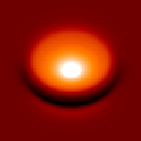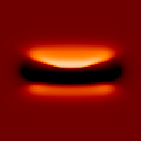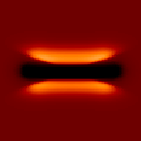RADMC: A 2-D continuum radiative transfer tool





General description
RADMC is a 2-D Monte-Carlo code for dust continuum radiative transfer circumstellar disks and envelopes. It is based on the method of Bjorkman & Wood (ApJ 2001, 554, 615), but with several modifications to produce smoother results with fewer photon packages.The RADMC package includes the following programs:
- RADMC: The basic FORTRAN program for computing the radiative transfer
through an axisymmetric configuration of dust. The main input is the density
structure of the dusty circumstellar material, the dust opacity tables and
the stellar parameters. The output is the dust temperature structure and
the scattering source functions. It also outputs a crude set of SEDs at
various inclinations, which are, however, only meant for testing. RADMC
can also compute the vertical structure of a disk for you, optionally.
Here is a list of capabilities of RADMC:
- Irradiation of a circumstellar envelope or disk by the photons from the central star (basic functionality).
- External (interstellar) radiation field.
- Iteration on the vertical structure
- Multiple dust species, each with its own dust temperature
- Quantum-heated grains (in combination with the PAHCODE program).
- RAYTRACE: A FORTRAN ray-tracing program which should be
executed after the RADMC run in order to produce images and/or SEDs at
any inclination. RAYTRACE can be used multiple times after a single RADMC run.
A summary of capabilities:
- Make spectrum (SED) at a given inclination
- Make spectra at N inclinations, divided evenly between incl=0 and incl=90 degrees, and automatically check flux conservation.
- Make images at a given wavelength (or given range of wavelengts) and given inclination, zoom-factor and position angle.
- Produce `circular images', which is the intensity at pixels arranged in concentric circles such that all spatial scales are resolved at once. These `images' stand at the basis of a robust IDL routine for computing the visibilities and phases for interferometry, without having to worry about the correct pixel scales etc.
- problem_*.pro: A set of IDL routines that can help the user set up the particular problem he/she wants to solve. These routines are just meant as a template for the user: they are not considered to be an integral part of the RADMC software. Instead it is expected that the user changes these routines to her/his needs. NOTE: There will be various versions of this set of IDL setup routines around. There is no real standard version of this set of routines.
- analyze.pro: An IDL library of routines for reading and plotting the results of the RADMC/RAYTRACE software.
Download
First of all, please heed this: You are free to use the code, but at your own responsibility. Please read the manual and follow the various pieces of advice on how to carefully prepare models and test their results!!!
Also, when using this code, please cite
the following paper, where this code was first used:
Dullemond and Dominik (2004), Astronomy and Astrophysics 417, 159-168.
You can now download in the following steps:
- Send me an email with your intent to use the code, so that I can add you to my RADMC-users list. This is not absolutely required (and you can also choose to do it later, once you have experimented with the code and are sure you're going to use it for your research). But it is important for you as the user to be kept in the loop in case of new bugfixes or so.
- You can now download version disk2d_rel_3.1_06.08.10.zip.
- Some older versions remain available disk2d_rel_3.1_03.11.08_a.zip, disk2d_rel_3.1_14.05.10.zip.
- In case you experience trouble or have any questions, just send me an email. Same is true for bug reports.
- Please don't forget to cite the above paper.
Future versions
I am currently working on a 3-D version of RADMC, including AMR grid refinement. A first beta version is available upon request. You can visit the RADMC-3D web page to see a preview.
Responsible: Simon Glover, last modification Mar/15/2011 14:05 CET

 Home page
Home page